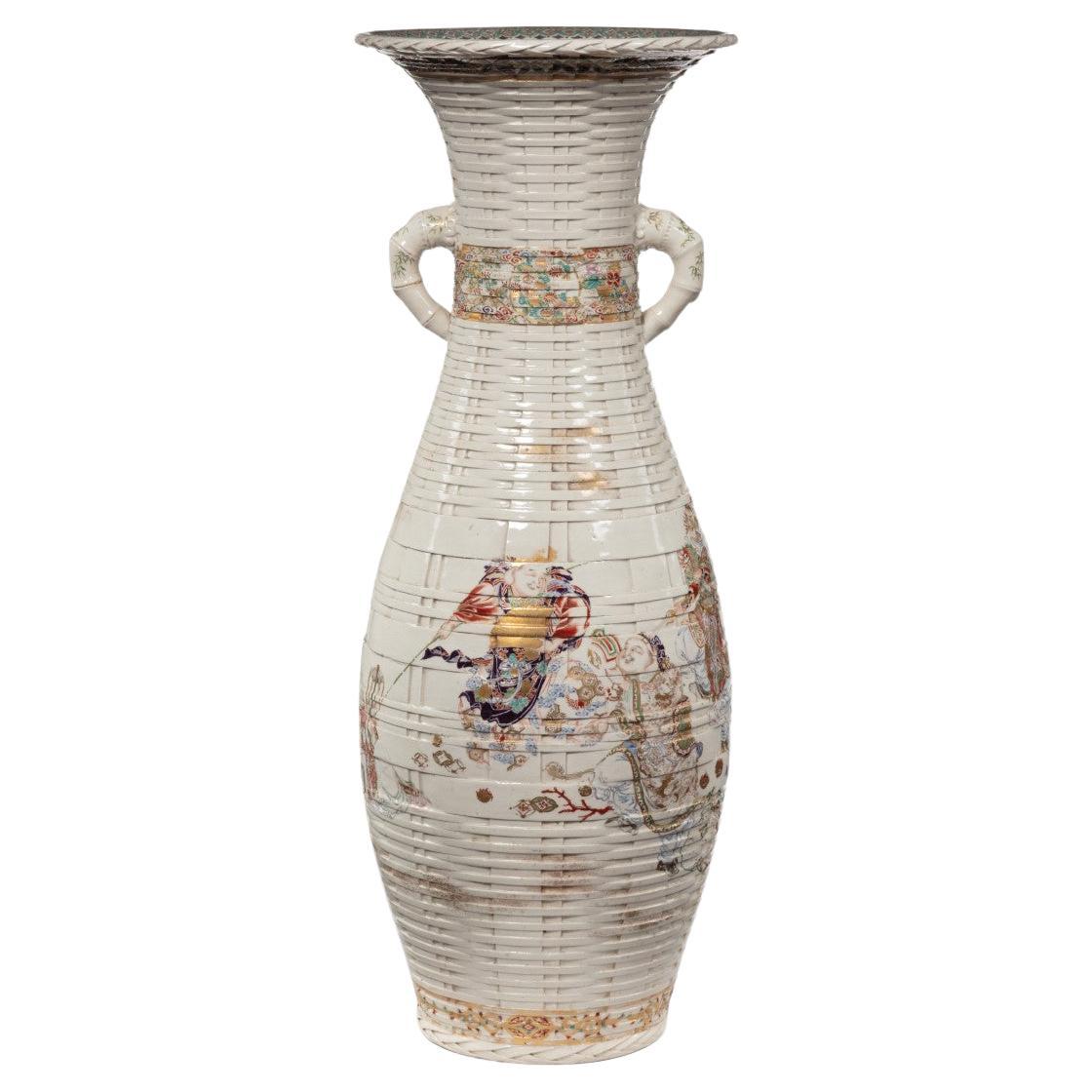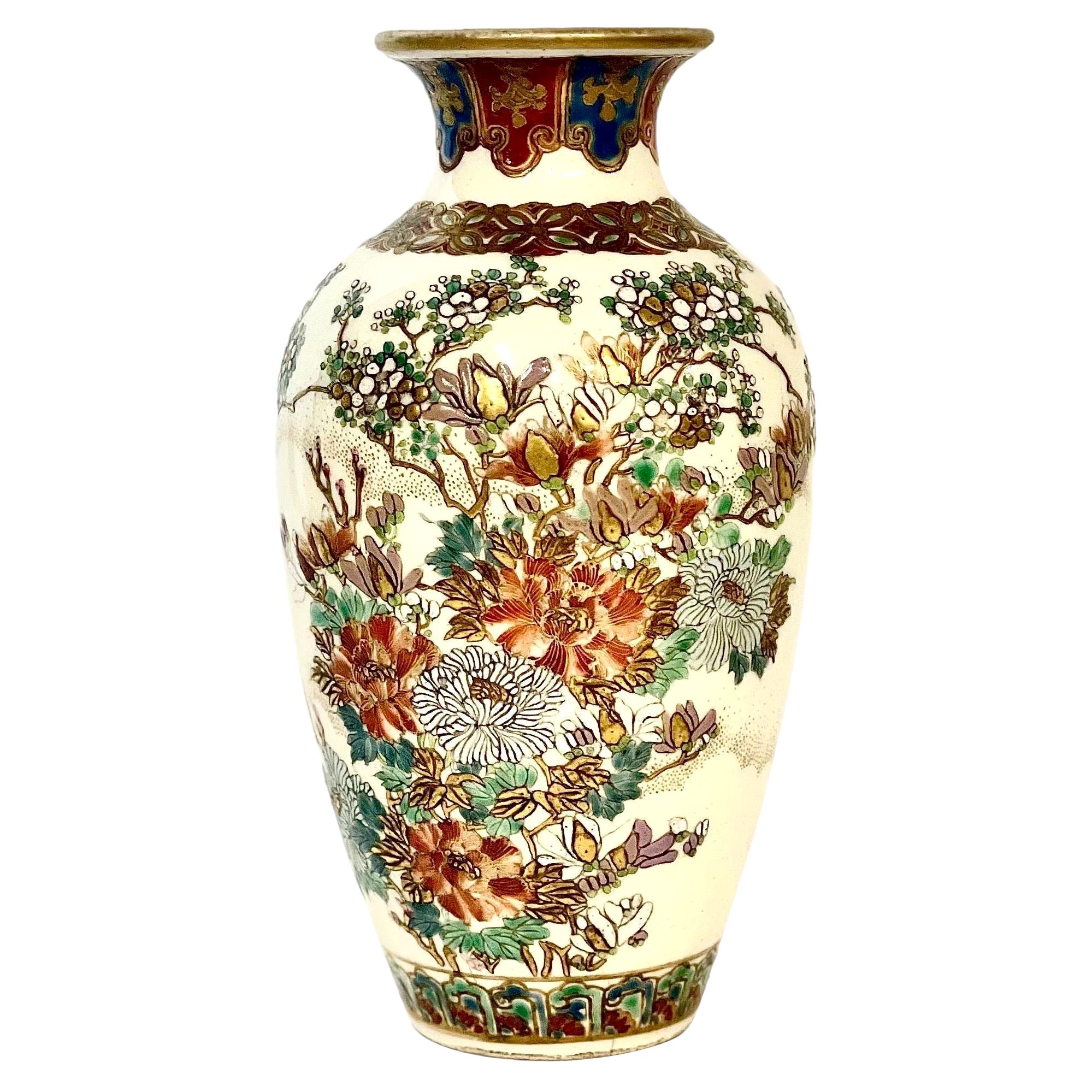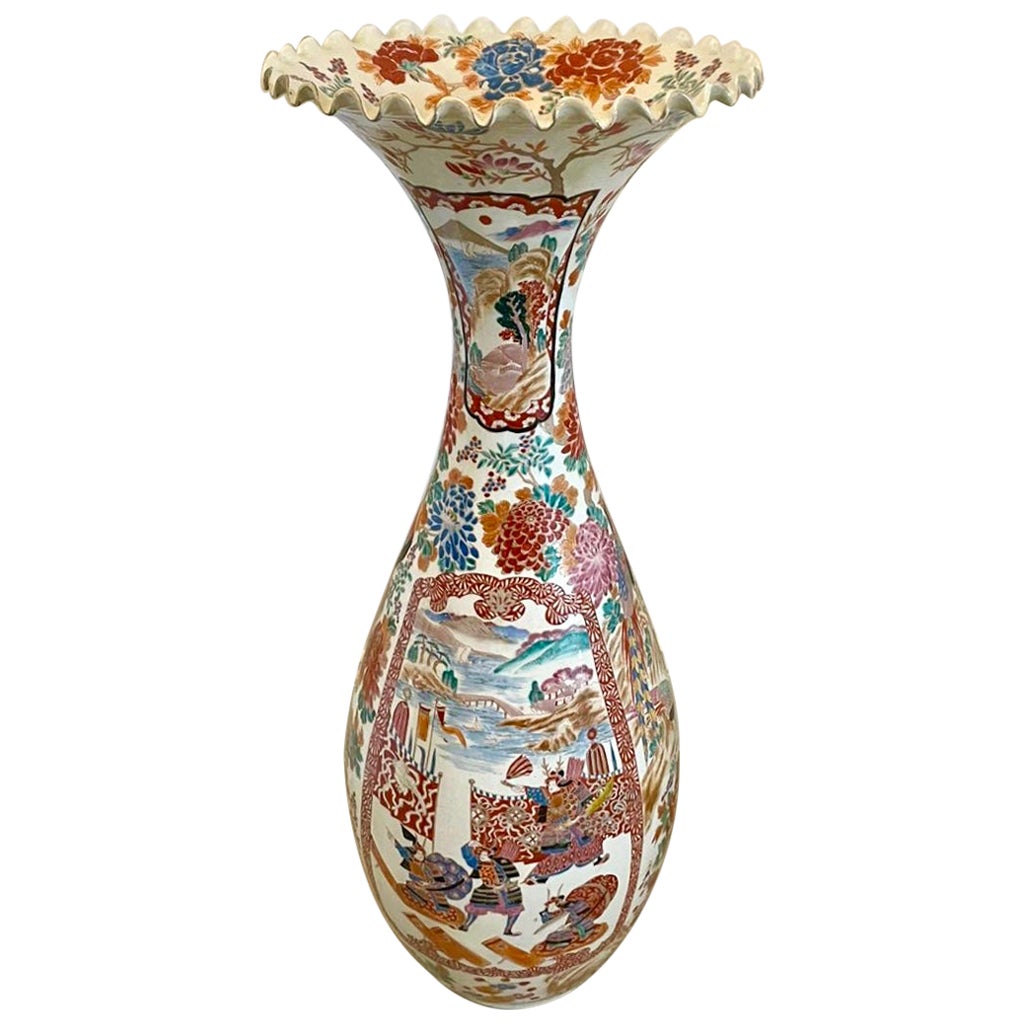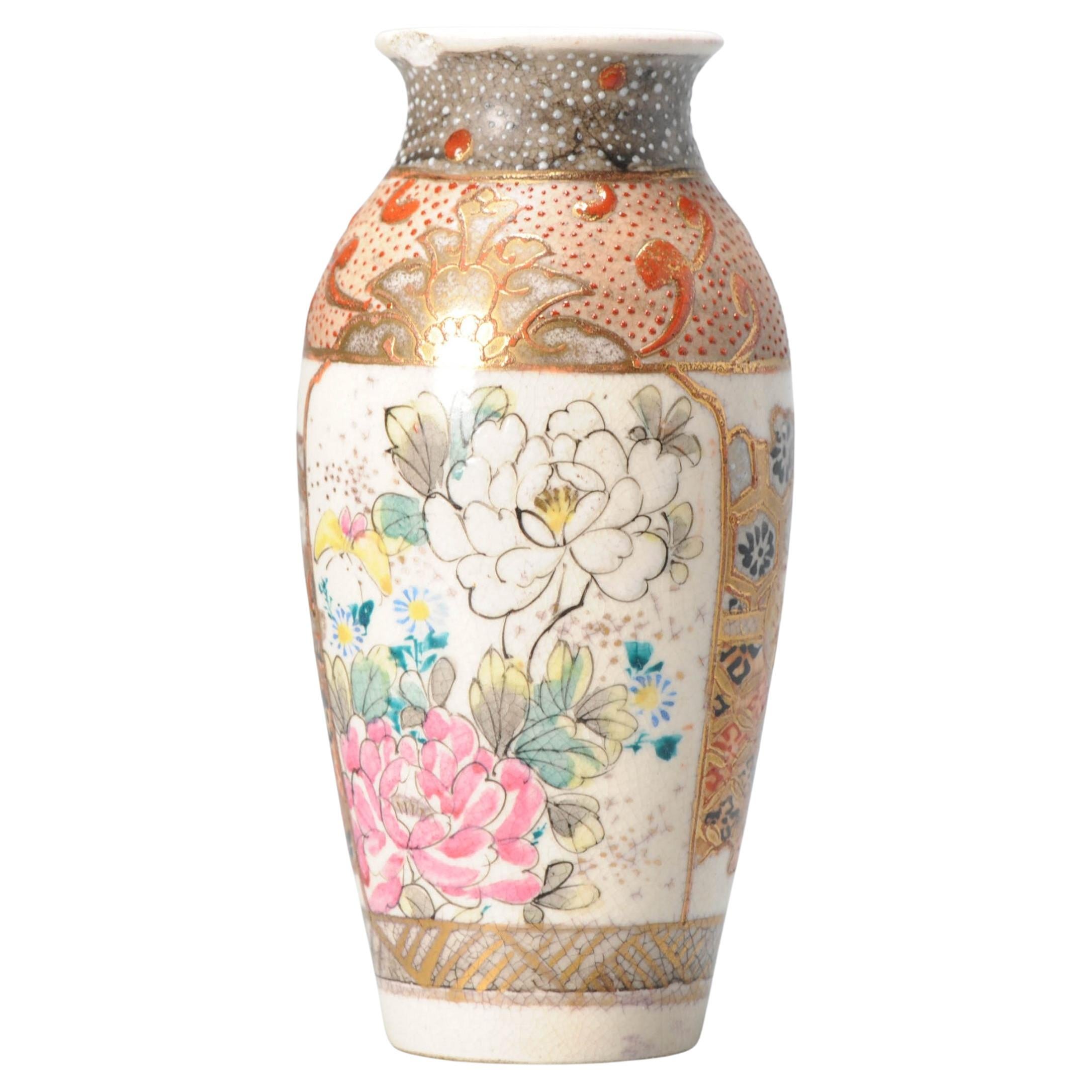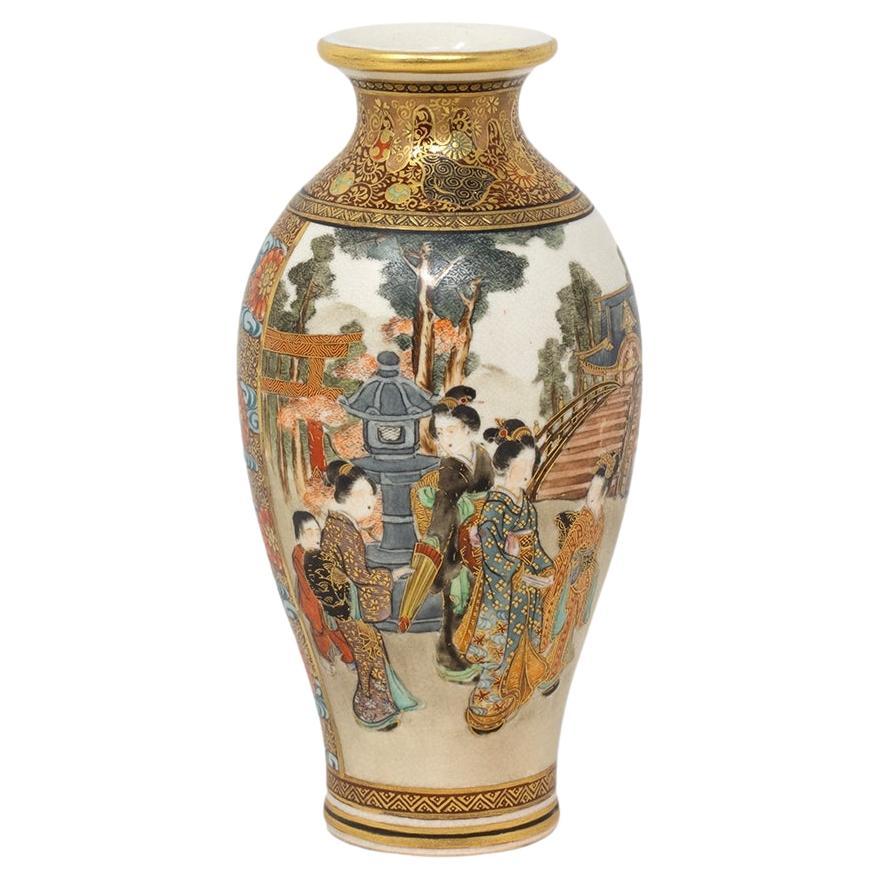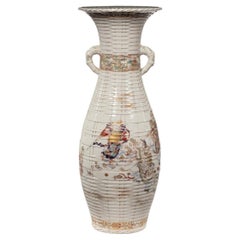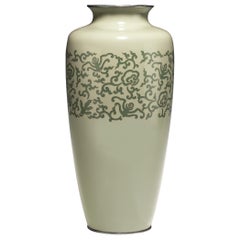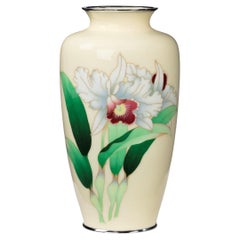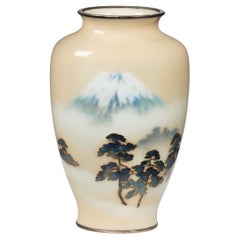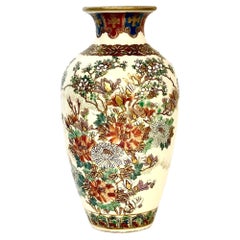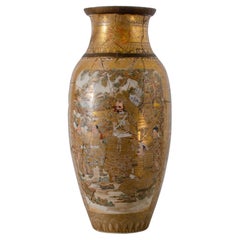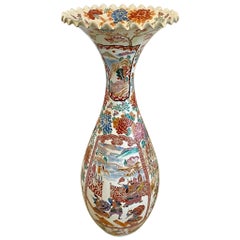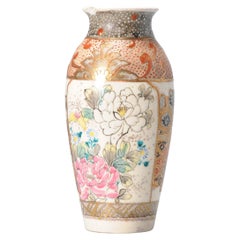Items Similar to Large Meiji Period Satsuma Earthenware Floor Vase
Want more images or videos?
Request additional images or videos from the seller
1 of 13
Large Meiji Period Satsuma Earthenware Floor Vase
$4,627.64
£3,375
€3,936.19
CA$6,336.83
A$7,045.69
CHF 3,678.87
MX$85,763.21
NOK 46,940.79
SEK 43,981.28
DKK 29,376.52
Shipping
Retrieving quote...The 1stDibs Promise:
Authenticity Guarantee,
Money-Back Guarantee,
24-Hour Cancellation
About the Item
A large Meiji period Satsuma earthenware floor vase, the of baluster form, painted in pastel overglaze enamels and gilding with two large sprays of flowers including prunus blossom, carnations, tiger-lilies, wistaria, peonies and petunias, the neck with brocade bands and applied faux-bamboo handles, all on an intricate basketweave ground. Japanese, circa 1875.
- Dimensions:Height: 27 in (68.58 cm)Width: 0.1 in (2.54 mm)Depth: 0.1 in (2.54 mm)
- Style:Meiji (Of the Period)
- Materials and Techniques:
- Place of Origin:
- Period:
- Date of Manufacture:circa 1875
- Condition:Wear consistent with age and use.
- Seller Location:Lymington, GB
- Reference Number:1stDibs: LU973027047012
About the Seller
5.0
Recognized Seller
These prestigious sellers are industry leaders and represent the highest echelon for item quality and design.
Established in 1982
1stDibs seller since 2013
132 sales on 1stDibs
Typical response time: 2 hours
Associations
LAPADA - The Association of Arts & Antiques Dealers
- ShippingRetrieving quote...Shipping from: Lymington, United Kingdom
- Return Policy
Authenticity Guarantee
In the unlikely event there’s an issue with an item’s authenticity, contact us within 1 year for a full refund. DetailsMoney-Back Guarantee
If your item is not as described, is damaged in transit, or does not arrive, contact us within 7 days for a full refund. Details24-Hour Cancellation
You have a 24-hour grace period in which to reconsider your purchase, with no questions asked.Vetted Professional Sellers
Our world-class sellers must adhere to strict standards for service and quality, maintaining the integrity of our listings.Price-Match Guarantee
If you find that a seller listed the same item for a lower price elsewhere, we’ll match it.Trusted Global Delivery
Our best-in-class carrier network provides specialized shipping options worldwide, including custom delivery.More From This Seller
View AllLarge Meiji Period Satsuma Earthenware Floor Vase
Located in Lymington, Hampshire
A large Meiji period Satsuma earthenware floor vase, the skittle shaped body painted in pastel overglaze enamels and gilding with a continuous frieze of the Seven Gods...
Category
Antique 1870s Japanese Meiji Ceramics
Materials
Enamel
Large Japanese Cloisonne Vase, Meiji Period
Located in Lymington, Hampshire
This large vase has a central continuous band of scrolling green karakusa on a pale green ground.
Signed/Inscribed: Ando mark.
Category
Antique Early 1900s Japanese Vases
Materials
Metal
Showa Period Tall Cream Ground Cloisonne Vase
Located in Lymington, Hampshire
A Showa period tall cream ground cloisonne vase, with two orchids and four spikey leaves, Japanese, mid 20th century.
Category
Mid-20th Century Japanese Showa Ceramics
Materials
Ceramic
Showa Period Rich Cream Ground Musen Cloisonne Enamel Vase by Ando
Located in Lymington, Hampshire
A Showa period rich cream ground musen cloisonne enamel vase with Mount Fuji by Ando, the snowy mountain rising above stands of fir trees, with impress...
Category
Vintage 1930s Japanese Showa Ceramics
Materials
Enamel
A small fine quality Meiji period cloisonné enamel vase
Located in Lymington, Hampshire
A small fine quality Meiji period cloisonne enamel vase, with silver wires and gilt rims decorated with lappets of dragons of ho-ho birds on a brown ground, with textile designs arou...
Category
Antique 1880s Japanese Meiji Metalwork
Materials
Metal
Showa Period Grey and Cream Cloisonné Vase
Located in Lymington, Hampshire
A Showa period grey and cream cloisonné vase, of squat ovoid form with continuous band of black blossoms and fleshy grey leaves round the shoulder, with as...
Category
Vintage 1980s Japanese Vases
Materials
Enamel
You May Also Like
Antique Japanese Taisho Satsuma Painted Vase
By Satsuma
Located in LA CIOTAT, FR
A petite and beautiful hand-decorated ceramic baluster vase, painted all around with traditional Japanese motifs, including native flora, birds and bamboo stems on a creamy glazed background. The colour palette is bold and bright, with highlights of green, red and blue, together with plentiful gilt relief...
Category
Early 20th Century Japanese Taisho Ceramics
Materials
Ceramic
Large Repaired Satsuma Vase, Meiji
Located in Savannah, GA
A large Meiji period Satsuma vase, late 19th century.
Fully shattered and repaired.
11 ½ inches wide by 24 ½ inches tall
Category
Antique Late 19th Century Japanese Meiji Ceramics
Materials
Ceramic
Large Antique 19th Century Quality Japanese Imari Floor Standing Vase
Located in Suffolk, GB
Large antique 19th century quality Japanese Imari floor standing vase having a splendid trumpet shaped scalloped edge top, fantastic hand painted panels with Japanese people in perio...
Category
Antique 19th Century Japanese Vases
Materials
Ceramic
$4,113 Sale Price
20% Off
Antique Meiji Period Japanese Satsuma Vase Floral Decoration, 19th Century
Located in Amsterdam, Noord Holland
Fabulous Japanese earthenware Satsuma Vase with nice decoration of flowers. Meiji period, 19/20th c
Lovely piece.
Additional information:
Material: Porcelain & Pottery
Japanese Sty...
Category
Antique 19th Century Japanese Meiji Vases
Materials
Porcelain
Japanese Meiji Period Satsuma Vase by Ryokuzan
Located in Newark, England
From our Japanese Satsuma Collection, we are delighted to offer this Japanese Satsuma Vase by Ryokuzan 緑山. The Satsuma vase of ovoid shape with a tapered body, circular foot rim, wai...
Category
Antique Early 1900s Japanese Meiji Ceramics
Materials
Ceramic, Earthenware, Pottery
Antique 19th Century Japanese Satsuma Vase Richly Decorated Marked Base Japan
Located in Amsterdam, Noord Holland
Lovely etailed piece. Marked on base with makers mark and mon crest
Condition
Overall condition perfect. Size: 294mm
Period
Meiji Periode (1867-1912).
Category
Antique 19th Century Japanese Meiji Ceramics
Materials
Earthenware
$863 Sale Price
20% Off
More Ways To Browse
Meiji Period Furniture
Meiji Period
Japanese Earthenware
Large Earthenware Vases
Antique Carnation
Japanese Earthenware Vase
Satsuma Meiji Period
Painted Floor Vase
Meiji Satsuma Vases
Satsuma Earthenware
Tiger Bamboo
Large Antique Floor Vases
Satsuma Large Vases
Japanese Satsuma Large Vase
Prunus Vase
Tiger Vase
Japanese Floor Vase
Tiger Lily
